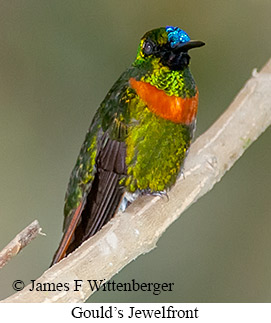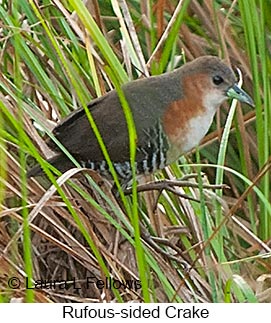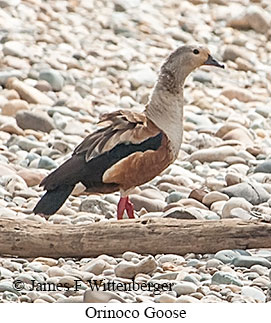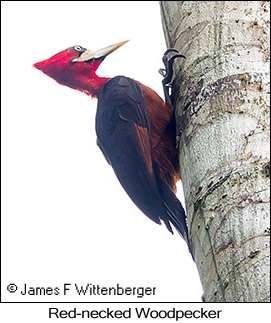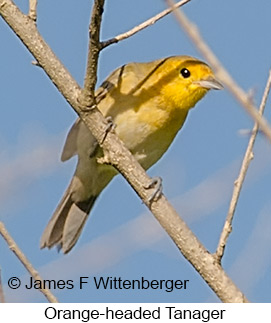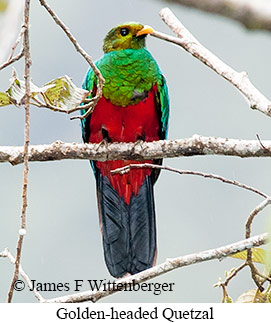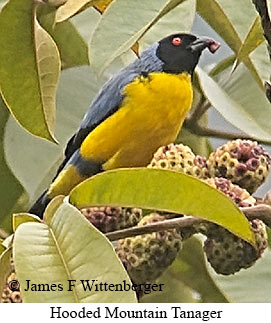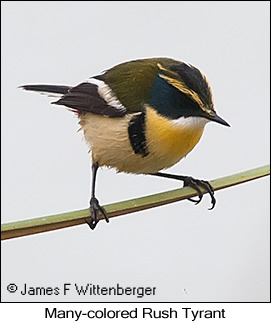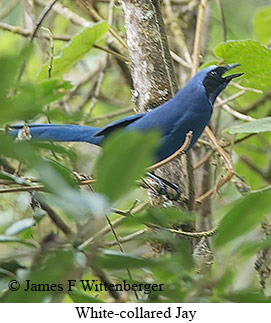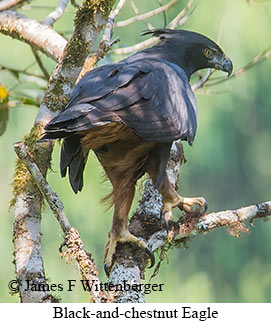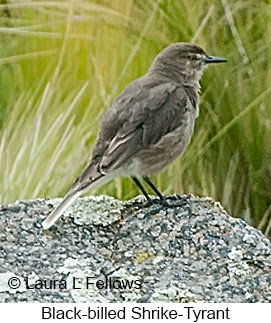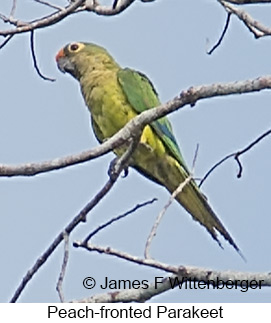BOLIVIA MEGA TOUR
Tour Description

BOLIVIA
BIRDING TOUR
ANY TIME*
| Duration: | 29 days, 28 nights |
| Group Size: | 2-6 |
| Anytime Price: | $12800 |
| Group Price: | $11500 |
| Single Suppl: | $800 |
| Est #Species: | 675-725 |
| Pace: | Moderate |
| Difficulty: | Moderate |
| * This tour is available for any dates of your choosing provided guide services and accommodations are available. | |
DAY 1 - ARRIVE SANTA CRUZ DE LA SIERRA
Arrive Santa Cruz de La Sierra. Overnight hotel in Santa Cruz.
DAY 2 - LOMAS DE ARENA & BOTANICAL GARDENS
Early start to birding in the Santa Cruz Botanical Gardens. The two main target species are Bolivian Slaty-Antshrike and Fawn-breasted Wren. Many other forest and Chaco species are present as well including Greater Rhea, Chaco Chachalaca, Green-cheeked Parakeet, Chestnut-fronted Macaw, Black-capped Antwren, Straneck's Tyrannulet, and Orange-headed Tanager. Then visit Lomas de Arena Municipal Park on the outskirts of Santa Cruz. Park habitats include sand dunes, savanna, dry forest, marshes, and large bodies of water. Interesting species include Red-winged Tinamou, White-bellied Nothura, Comb Duck, White-tufted Grebe, Ringed Teal, White-eared Puffbird, Spot-backed Puffbird, White Woodpecker, Red-legged Seriema, Peach-fronted Parakeet, Chotoy Spinetail, and Hudson's Black-Tyrant. Overnight hotel in Santa Cruz.
DAY 3 - FLIGHT & RIBERALDA
Early morning flight to Trinidad followed by early afternoon flight to Riberaldta. After arrival some afternoon birding near Riberalta. The primary target species is Masked Antpitta, which can often be found at Puerto Hamburgo near Riberalta. Overnight hotel in Riberalta.
DAY 4 - RIBERALTA
The normal plan is to first focus on finding Masked Antpitta if not seen the previous day. After that, there are basically two options. Bird the cerrado west of Riberalta toward Pampas de San Lorenzo or go north to bird tropical Amazonian rainforest. It takes two days to do both. The cerrado is home to the second target species, Rufous-sided Pygmy-Tyrant. Overnight hotel in Riberalta.
DAY 5 - RIBERALTA & TRANSFER
All day transfer to Rurrenabaque and then Sadiri Lodge, a 12½ hour drive. The lodge is located 2½ hours drive from Rurrenabaque and protects some 34,000ha of land within Madidi National Park. Night at Sadiri Lodge.
DAY 6 - SADIRI LODGE
All day birding around Sadiri Lodge. The habitat is mainly foothill tropical rainforest. Much of the birding is along the road through the forest. A major appeal of the site is the ability to bird from ridges looking down into the forest canopy along the road, making canopy birds much easier to see. Mixed species flocks abound in the forest and are easy to see because of this topography. Over 500 species have been seen around the lodge and the surrounding national park. Among the many possibilities are Pavonine Cuckoo, White-throated Woodpecker, Rose-fronted Parakeet, Hairy-crested Antbird, Sharp-tailed Streamcreeper, Round-tailed Manakin, Sharpbill, Yungas Tyrannulet, Slaty-capped Shrike-Vireo, Olive Oropendola, and Yellow-shouldered Grosbeak. In addition to forest birding, hummingbird feeders at the lodge attract a nice variety of species including Gould's Jewelfront, Blue-tailed Emerald, Gray-breasted Sabrewing, and Fork-tailed Woodnymph. Night birding could produce Rufescent Screech-Owl, Crested Owl, Band-bellied Owl, and Black-banded Owl. Overnight Sadiri Lodge.
DAY 7 - SADIRI LODGE & TRINIDAD
Morning transfer 7 hours drive to the town of Trinidad. Afternoon birding gallery forest outside Trinidad looking for the near mythical Unicolored Thrush. Other possibilities include Buff-bellied Hermit, Band-tailed Antbird, Beni Grackle, and Gray-headed Tanager. Overnight hotel in Trinidad.
DAY 8 - TRINIDAD & BARBA AZUL
Early morning birding outside Trinidad as time permits. Charter flight to Barba Azul Reserve followed by afternoon birding there. Night at Barba Azul Lodge.
DAYS 9-10 - BARBA AZUL
Barba Azul, which means Blue-throated Macaw in Spanish, protects the stronghold of this critically endangered species. The last remaining roosting site of this species was discovered in 2007 with a population of some 70 individuals. The total population is around 400. Barba Azul is the best place in the world to see them. Other sites around Trinidad are also very good. The habitat at Barba Azul is mainly natural tall-grass savanna, the only remaining ungrazed savanna in Bolivia. A second key species with limited range in Bolivia is Cock-tailed Tyrant. Many other interesting birds are found there as well, including Red-winged Tinamou, Orinoco Goose, Long-tailed Ground Dove, Rufous-sided Crake, Chaco Eagle, Yellow-collared Macaw, Large-billed Antwren, Greater Thornbird, Cinereous-breasted Spinetail, Sulphur-bellied Tyrant-Manakin, Hudson's Black-Tyrant, White-rumped Monjita, Streamer-tailed Tyrant, Dull-capped Attila, and Rusty-collared Seedeater. Extensive wetlands attract large numbers of widely distributed water birds.In addition to birds, a number of interesting mammals are present and sometimes seen in the reserve including Giant Anteater, Colocolo, Cougar, Jaguar, and Maned Wolf. Overnights at Barba Azul Lodge.
DAY 11 - CHARTER FLIGHT TO TRINIDAD & SANTA CRUZ
Morning chartered flight from Barba Azul. Afternoon flight to Santa Cruz. Night at hotel in Santa Cruz.
DAY 12 - TRANSFER & REFUGIO LOS VOLCANES
Morning transfer to Refugio Los Volcanes, about a 2 hour drive from Santa Cruz to Bermejo. From there transfer down a steep road to the lodge area. The habitat is semi-humid foothill forest. Rest of day birding the reserve. Notable possibilities include Gray Tinamou, Brown Tinamou, White-throated Piping-Guan, a recent split from Blue-throated Piping-Guan, Razor-billed Curassow, Rufous-breasted Wood-Quail (secretive and hard to see), the spectacular Red-necked Woodpecker, Inambari Woodcreeper, Black-capped Antwren, Slaty Gnateater, Bolivian Tapaculo, Short-tailed Antthrush, Yungas Manakin, Sclater's Tyrannulet, and many tanagers. A key target species is the elusive Bolivian Recurvebill, whose presence depends on the condition of bamboo stands around the lodge. During dry season Andean Condors regularly soar overhead. Large numbers of Mitred Parakeets and Turquoise-fronted Parrots are usually present along with less common Military Macaws. Night birding may produce Rufescent Screech-Owl and Band-bellied Owl. Overnight Refugio Los Volcanes Lodge.
DAY 13 - REFUGIO LOS VOLCANES
All day birding trails through the reserve. See previous day for birding possibilities. Overnight Refugio Los Volcanes Lodge.
DAY 14 - TRANSFER TO SAMAIPATA & QUIRUSILLAS
After early breakfast transfer to Samaipata, a 2½ hour drive. Rest of day bird semi-humid cloud forest above Samaipata around Quirusillas. The main target species is the vulnerable Tucuman Parrot. A second key species is Slaty Elaenia, which has only been seen there during rainy season from December-April. Other possibilities include Red Guan, White-throated Antpitta, Dot-fronted Woodpecker, and Golden-winged Cacique. Andean Condors are sometimes seen soaring overhead. A brief stop at the waterfall outside Samaipata is worth a visit for Sharp-tailed Streamcreeper. Overnight Samaipata.
DAY 15 - QUIRUSILLAS & TRANSFER TO PERERETA
Early departure for birding Laguna Esmeralda and Quirusillas again seeking any species missed previous day. Afternoon transfer to Perereta. Overnight Armonia Lodge in Perereta.
DAY 16 - RED-FRONTED MACAW RESERVE & TRANSFER TO COMARAPA
Morning visit the top of the cliffs above Perereta looking for 3 key species, Cliff Parakeet, Red-fronted Macaw, and Bolivian Blackbird. Feeders around the lodge attract White-fronted Woodpecker, White-tipped Plantcutter, and several tanager species. After breakfast transfer to Comarapa with some birding stops enroute, arriving in time for lunch. Afternoon birding above Comarapa in Siberia cloud forest (see below). Overnight hotel in Comarapa.
DAY 17 - SIBERIA CLOUD FOREST & COMARAPA YUNGAS
Depart before dawn for Siberia cloud forest. All day birding roadside trails of the area. An effort will be made to see the difficult Rufous-faced Antpitta. Other target species include Diademed Tapaculo, Black-throated Thistletail, Light-crowned Spinetail, and Chestnut-crested Cotinga. Numerous other birds are likely this very birdy day including Black-hooded Sunbeam, Violet-throated Starfrontlet, Red-tailed Comet, Ocellated Piculet, Rufous Antpitta, Olive-crowned Crescentchest, Bolivan Brushfinch, Rust-and-yellow Tanager, Blue-capped Tanager, and Chestnut-bellied Mountain Tanager. Overnight hotel in Comarapa.
DAY 18 - TRANSFER TO COCHABAMBA
Depart early for long transfer to Cochabamba with several birding stops enroute. Possibilities near Siberia include Darwin's Nothura, White-winged Black-Tyrant, Yellow-billed Tit-Tyrant, Ringed Warbling Finch, and Great Pampa-Finch. Later stops may yield Giant Hummingbird, Rock Earthcreeper, Creamy-breasted Canastero, White-tipped Plantcutter, Black-hooded Sierra Finch, and Bolivian Warbling Finch. A stop near Cochabamba is sometimes good for Wedge-tailed Hillstar. Raptors including Black-chested Buzzard Eagle are possible along the way. Overnight hotel in Cochabamba.
DAY 19 - UPPER CHAPARE ROAD
The Chapare Road leads into the highlands northeast of Cochabamba toward the town of Chapare. The upper section goes up and over the east slope of the Andes and is home to some good birds. Much of the forest has been cut but some patches remain. One target species is the rare Hooded Mountain-Toucan. Another is the uncommon Yellow-rumped Antwren. A third target species usually seen is Orange-browed Hemispingus. Difficult to see but possible are Huayco Tinamou and Stripe-faced Wood-Quail. A side road leading to Tablas Monte goes through disturbed forest and cleared fields. A number of interesting species are possible including Violet-throated Starfrontlet, Golden-headed Quetzal, Black-winged Parrot, Black-throated Thistletail, Band-tailed Fruiteater, and Chestnut-bellied Mountain Tanager. Other possibilities along the upper road include Barred Antthrush, Chestnut-crested Cotinga, White-eared Solitaire, Hooded Mountain Tanager, Grass-green Tanager, and Scarlet-bellied Mountain Tanager. Overnight hotel in Cochabamba.
DAY 20 - LOWER CHAPARE ROAD
All day birding the lower section of the Chapare Road. This section, between 800 and 1800m elevation has some pristine forest but much of the forest has been cut. Most birding is along the road despite heavy traffic as the slopes are steep and have few trails up them. A side road through a forest filled with bamboo patches is often good for the rare Green-throated Tanager. Some effort will be spent seeking Blue-banded Toucanet, Yellow-rumped Antwren, the skulky Yungas Tody-Tyrant and the very uncommon Upland Antshrike. Overnight hotel in Cochabamba.
DAY 21 - CERRO TUNARI & LAGUNA ALALAY
Morning birding the highlands of Cerro Tunari near Cochabamba. Parque Nacional Tunari is reached up the steep Quillacollo road leading into the highlands northwest of the city toward Villa Tunari. This road is considered by many one of the best birding sites in South America The road goes through an agricultural area before rising steeply through scrub and Polylepis woodland to eventually reach Puna grassland. The scrub habitat along the lower section is good for Bolivian Warbling Finch and the highly localized endemic Cochabamba Mountain-Finch along with Bolivian Blackbird and Gray-bellied Flowerpiercer. Higher up is the scarce and very localized Wedge-tailed Hillstar as well as Maquis Canastero. The Polylepsis forest around 3500m is home to Tawny Tit-Spinetail and one of the few places where Rufous-bellied Mountain Tanager is possible. The latter species and also Cochabamba Mountain-Finch are also possible in the first few kilometers of the nearby Liriuni Road if missed here. The highest elevations of Puna grassland above 4000m is sometimes good for Short-tailed Finch and several ground-tyrants. Other possibilities this day include Red-tailed Comet, Green-barred Woodpecker, Andean Parakeet, Rock Earthcreeper, Bolivian Earthcreeper, Brown-capped Tit-Spinetail, Scribble-tailed Canastero, Puna Canastero, Spot-billed Ground-Tyrant, Cinnamon-bellied Ground-Tyrant, Fulvous-headed Brushfinch, Black-hooded Sierra Finch, Ringed Warbling Finch.
Afternoon visit Laguna Alalay within the city limits of Cochabamba. The lake is very good for waterfowl. The most interesting is Andean Duck along with White-tufted Grebe. Reeds along the shoreline are good for Wren-like Rushbird and Many-colored Rush Tyrant. Also of interest is Yellow-winged Blackbird, a possible future split from Titicaca Blackbird. Transfer to airport in time for early evening flight to La Paz. Overnight hotel in La Paz.
DAY 22 - SORATA ROAD & LAKE TITICACA
Depart very early for the upper Sorata Valley. The main target species is Berlepsch's Canastero, found in remnant scrub habitat in the valley. Also present there is Black-hooded Sunbeam. Enroute to the canastero site outside Sorata a few ponds will likely yield Chilean Flamingo, Giant Coot, and Puna Ibis. In late afternoon visit Lake Titicaca. The primary target species there is the flightless Titicaca Grebe. Overnight hotel in La Paz.
DAY 23 - COROICO ROAD
Depart very early for the town of Coroico taking the new highway out of La Paz. Birding begins at higher elevation along the new road where Rufous-bellied Seedsnipe is likely. A site 4km before La Cumbre is a good place for White-winged Diuca-Finch. Also present in the cloud forest around La Cumbre, the highest point of the road at 4770m, are Black-and-chestnut Eagle, Blue-mantled Thornbill, Hooded Mountain-Toucans, White-collared Jay, Plumbeous Sierra-Finch, and the difficult to see Short-tailed Finch. The Pongo area around 3800m elevation is a good site for Scribble-tailed Canastero. Some of the best birding is along the Old Coroico Road, which begins about two thirds of the way to the town of Coroico. The old road is known as the "Death Road", aptly named as it is a narrow dirt road carved out of the very steep hillsides. The key target species is the scarce Scimitar-winged Piha. Other possibilities include Rufous-capped Antshrike, Upland Antshrike, Band-tailed Fruiteater, Bolivian Tyrannulet, and Andean Solitaire. Overnight hotel in Coroico.
DAY 24 - COROICO ROAD
Morning will be devoted to seeking out lower elevation birds around Coroico. Notables include Brown Tinamou, Diademed Tapaculo, Light-crowned Spinetail, Rufous-bellied Bush-Tyrant, and Orange-browed Hemispingus. Afternoon transfer back to La Paz, stopping at higher elevation sites as needed for any species missed the previous day. Overnight hotel in La Paz.
DAY 25 - TRANSFER TO APOLO
All day long drive to Apolo. It takes all day to get there. Apolo is located on a high Andean plateau and is mostly scrub and cattle pasture. It's the hub for birding Aten to the south, Machariapo forest to the north, and Apolo Yungas to the southwest. Overnight hotel in Apolo.
DAY 26 - ATEN
The habitat near Aten south of Apolo is Bolivian Cerrado, an area of grassland and scrub on a plateau in the Apolo region. There is also some good Yungas cloud forest south of town. The main target species is the endemic Palkachupa Cotinga. A second and more difficult target is Green-capped Tanager. Seeing the tanager is hit or miss. It's typically seen in flocks in open savanna with scattered trees. The forest in the western valley south of Aten is usually bettern than the eastern valley. The savanna can be good for raptors such as King Vulture, Black-and-white Hawk-Eagle, Chaco Eagle, and White-tailed Hawk. Other possibilities include Black-capped Tinamou, Red-winged Tinamou, Rufous-crested Coquette, Rufous-sided Crake, and White-eared Puffbird. Interesting species in the cloud forest include Hooded Tinamou, Black-capped Tinamou, Pavonine Cuckoo, Black-and-chestnut Eagle, Red-stained Woodpecker, Ashy Antwren, Rufous-margined Antwren, Chestnut-crested Cotinga, and Yungas Tyrannulet. Overnight hotel in Apolo.
DAY 27 - MACHARIAPO FOREST
All day birding the dry forest of Machariapo Valley north of Apolo. This valley is home to the recently described and enigmatic Inti Tanager, This species is a seasonal migrant and absent from April to October. Unfortunately the best time to see Rufous-vented Ground-Cuckoo is the same dry period when the tanager may be absent. The Machariapo Valley is the only dependable site in Bolivia and the best site in the world to see that species. A variety of more widely distributed species are also present, including some from the Chaco region around Santa Cruz as well as middle montane species such as Plain Antvireo, Yungas Manakin, Two-banded Warbler, and White-winged Tanager. Overnight hotel in Apolo.
DAY 28 - APOLO YUNGAS & TRANSFER
The road from Apolo back to La Paz goes through lush middle elevation montane forest of Cotapata National Park. Early morning birding there is worthwhile to seek cloud forest species that may have been missed the preceding two days. Some possibilities include Andean Condor, Red-necked Woodpecker, Streak-throated Bush Tyrant, Black-billed Shrike-Tyrant, and various other Yungas birds. Rest of day long transfer to La Paz, arriving at the airport in the evening for overnight flight home. End of tour at the airport.
DAY 29 - ARRIVE HOME
International flight home.
TOUR NOTES
Group price applies for 3-6 persons.
ADDITIONAL INFO
(Not on Menu Above)
BIRDING LOCALES
